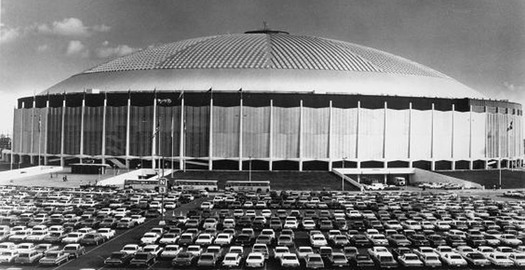
November 6, 2013
Can the Doomed Astrodome Save Modernism?

Earlier this week, Houston voters declined to fund a bond initiative to renovate the Astrodome, meaning the landmark bubble known as the Eighth Wonder of the World is likely to be demolished. It’s a bitter pill. The historical significance of the building as the first multipurpose domed stadium is considerable, and its various innovations are remarkable testaments to the outsized, can-do spirit that defined America generally and Texas in particular at midcentury. Here was a building that befitted a city and a nation shooting men into space.
If it never worked perfectly, the place had a sense of optimism about it. How could you not be charmed by such an enormous, open room with its luminous, lucite panel ceiling? The place had its own weather patterns, not to mention female ushers — Spacettes — who wandered the aisles in gold lame, an electronic scoreboard before they were a commonplace, and of course its eponymous fake grass. (Installed after the real stuff failed to grow.) This was the future, a pleasure dome, surrounded by an ocean of parking, a place suited to an automotive city.
The Astros never managed a World Series in the place — but, oh, those uniforms — and the Oilers didn’t win the Super Bowl. So what? Billie Jean King dispatched Bobby Riggs in their famous Battle of the Sexes, one of the signal moments in 20th century American culture.
In a recent article in Architect magazine tied to the destruction of Prentice Hospital in Chicago — another travesty — my Design Observer colleague Alexandra Lange suggested the modern preservation movement was in need of a Penn Station Moment; the destruction of a monument so beloved that it would galvanize a movement to prevent future travesties. The Astrodome is as good a test case for that theory as one could hope to find. It is the single most recognizable building in Houston, a symbol of the city, and if it is lost, the city will regret its decision for generations to come. (It’s truly hard to imagine a city intentionally destroying its signature work of architecture.)
But for all that, if it is torn down, I strongly suspect it will fail to inspire a movement. I doubt any building could. I suspect the future will be about incremental gains and losses, and the best those of us who believe in modern preservation can do is fight the good fight as best we can, using every tool available. It’s not going to come easy.
To the barricades!
Observed
View all
Observed
By Mark Lamster
Related Posts

Innovation
Vicki Tan|Books
How can I design at a time like this?

Civic Life
Bert de Muynck|Essays
Walkie talkie: An architect-turned-tour guide on designing presence in Lisbon

Business
Courtney L. McCluney, PhD|Essays
Rest as reparations: reimagining how we invest in Black women entrepreneurs

Design Impact
Seher Anand|Essays
Food branding without borders: chai, culture, and the politics of packaging
Related Posts

Innovation
Vicki Tan|Books
How can I design at a time like this?

Civic Life
Bert de Muynck|Essays
Walkie talkie: An architect-turned-tour guide on designing presence in Lisbon

Business
Courtney L. McCluney, PhD|Essays
Rest as reparations: reimagining how we invest in Black women entrepreneurs

Design Impact
Seher Anand|Essays
